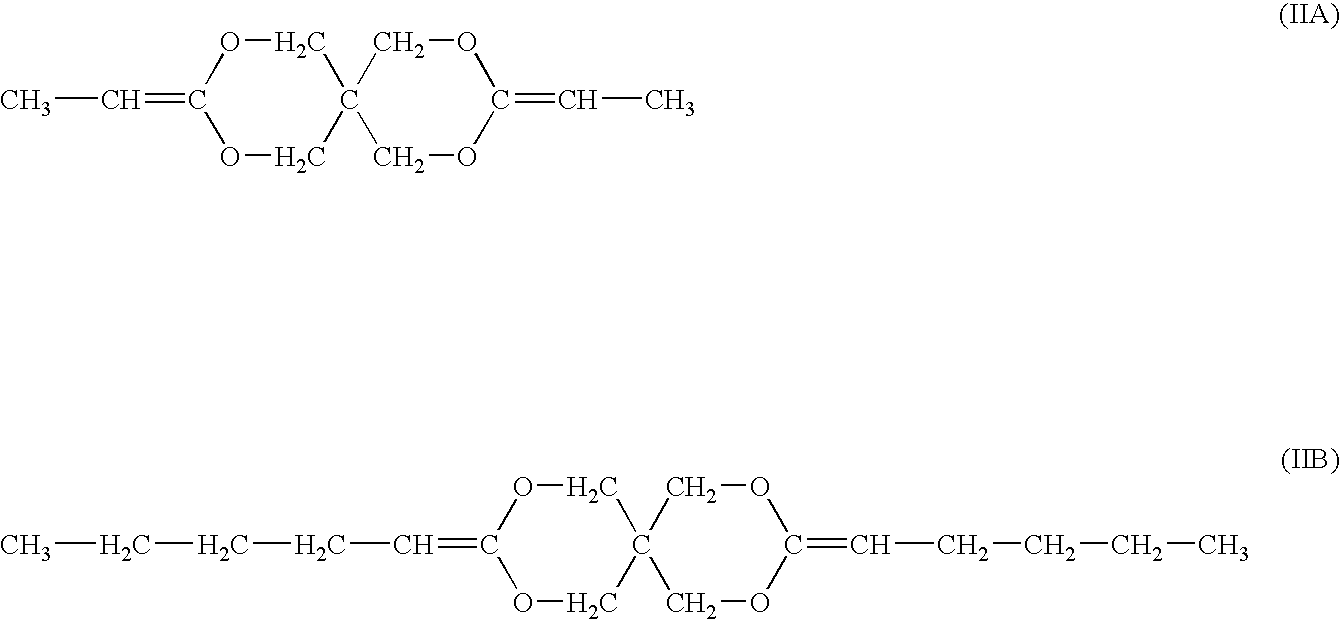Coatings For Drug Delivery Devices Having Gradient Of Hydration
a drug delivery device and gradient technology, applied in the direction of prosthesis, bandages, blood vessels, etc., can solve the problems of intimal flaps or torn arterial linings affecting the patient's physiology, etc., and achieves a lower degree of hydration, and higher degree of hydration
- Summary
- Abstract
- Description
- Claims
- Application Information
AI Technical Summary
Problems solved by technology
Method used
Image
Examples
example 1
Synthesis of poly(ethylene glycol-co-3,9-diethylidene-2,4,8,10-tetraoxaspiro-[5,5]-undecane-co-1,4-butanediol) (PEG-DETOSU-BD)
[0054] About 25 g (12.5 mmol) of PEG having molecular weight (Mw) of about 2,000 can be placed into a 1-liter round bottom flask equipped with a mechanical stirrer. PEG can be treated to remove water by being heated to about 80° C. using an oil bath, while being stirred under vacuum of about 25 mm Hg. About 400 g of tetrahydrofuran (THF) and about 5.74 g (27.08 mmol) of DETOSU can be added to the flask and dissolved with continued stirring. A solution of p-toluenesulfonic acid in THF having concentration of about 25 g / l can be prepared and about 10 drops of this solution can be added to the contents of the flask. The stirring can continue for about 1 hour while the contents of the flask are maintained at about 80° C. About 8.53 g (16.67 mmol) of 1,4-butanediol can then be added to the flask, and the stirring can continue for about 1 more hour while the conte...
example 2
Synthesis of poly(trans-cyclohexanedimethanol)-co-3,9-diethylidene-2,4,8,10-tetraoxaspiro-[5,5]-undecane-co-1,6-hexanediol (CHDM-DETO SU-HD)
[0056] A poly(ortho ester) can be synthesized of DETOSU and a diol component. The diol component can comprise a mixture of trans-cyclohexanedimethanol (CHDM) and 1,6-hexanediol (HD), the mixture having the molar ratio between CHDM and HD of about 7:3. A synthesis method described in Example 1 can be used. CHDM-DETOSU-HD is quite hydrophobic and is expected to have the degree of hydration of less than about 1 vol. %.
example 3
Synthesis of poly(3,9-diethylidene-2,4,8,10-tetraoxaspiro-[5,5]-undecane-co-1,10-decanediol (DETOSU-DD)
[0057] About 13.94 g (80 mmol) of 1,10-decanediol can be placed into a 500 ml round bottom flask equipped with a mechanical stirrer. Water can be removed form the diol by heating it above melting to about 80° C. using an oil bath, while being stirred under a vacuum of about 25 mm Hg. About 100 ml of THF and about 16.98 g (80 mmol) of DETOSU can be added to the flask and dissolved with stirring. A solution of p-toluenesulphonic acid in THF having a concentration of about 1 mass % can be prepared and about 12 drops of this solution can be added to the contents of the flask. The stirring can continue for about 1 hour while the contents of the flask are maintained at about 80° C. The reaction mixture can be cooled and the polymer isolated on a rotoevaporator. The polymer can then be purified by dissolution in dry methanol or chloroform, followed by precipitation with hexane. DETOSU-DD...
PUM
| Property | Measurement | Unit |
|---|---|---|
| temperature | aaaaa | aaaaa |
| body temperature | aaaaa | aaaaa |
| molecular weight | aaaaa | aaaaa |
Abstract
Description
Claims
Application Information
 Login to View More
Login to View More - R&D
- Intellectual Property
- Life Sciences
- Materials
- Tech Scout
- Unparalleled Data Quality
- Higher Quality Content
- 60% Fewer Hallucinations
Browse by: Latest US Patents, China's latest patents, Technical Efficacy Thesaurus, Application Domain, Technology Topic, Popular Technical Reports.
© 2025 PatSnap. All rights reserved.Legal|Privacy policy|Modern Slavery Act Transparency Statement|Sitemap|About US| Contact US: help@patsnap.com



